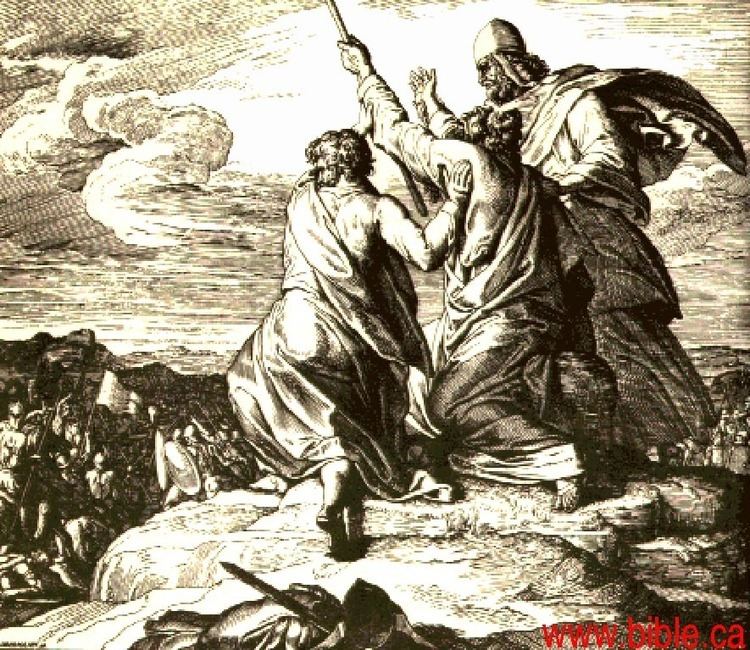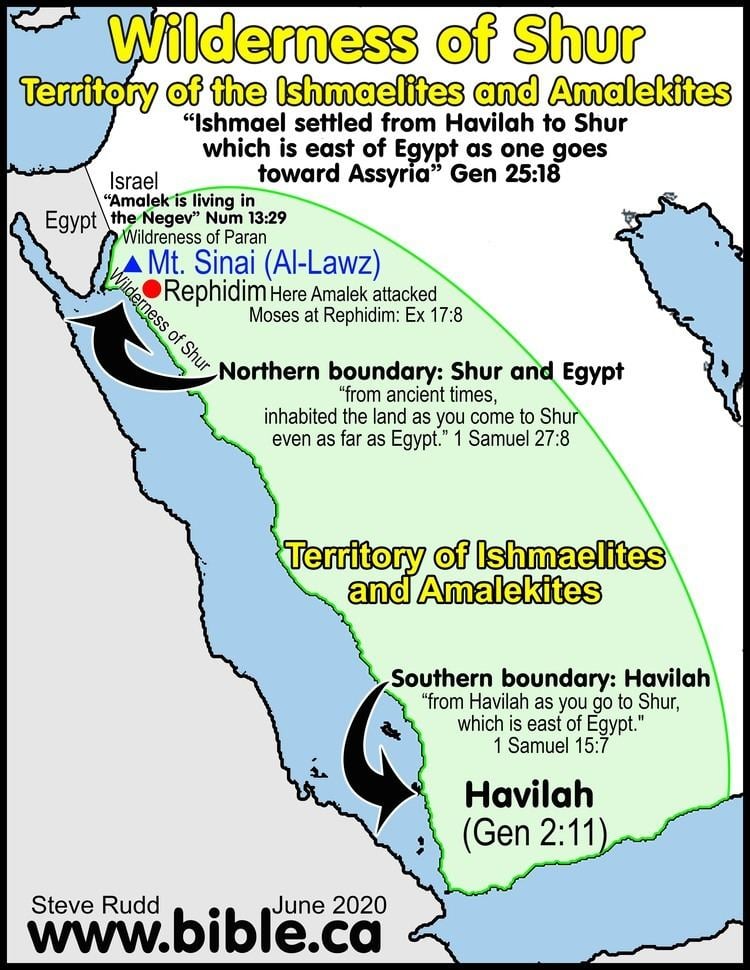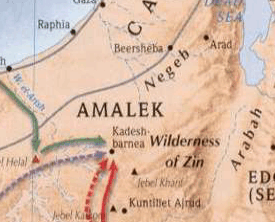Great-grandmother Rebecca | ||
 | ||
Similar | ||
Amalek (Hebrew: עֲמָלֵק, Amalek, ʻĂmālēq) occurs in the Old Testament of the Bible and refers to a grandson of Esau, the descendant nation of Amalekites, and the territories of Amalek which they inhabited.
Contents
- Etymology of Amalek
- Amalekite territory
- Exegesis of origins
- Judaic views of the Amalekites
- Extermination of the Amalekites
- Armenians associated with Amalekites
- History
- Nazis associated with Amalekites
- Zionists associated with Amalekites
- In Kahanism
- Iranians as Amalekites
- Arabs as Amalekites
- Crusades
- References

The Old Testament, accepted by Jews and Christians, describes the Amalekites as a nomadic tribe which lived in ancient Israel and in the land called Moab, what the Romans called Arabia Petraea (Moab and the desert of Sinai), a region depopulated in the fourteenth century BCE (maybe by the Egyptian Akhenaten, who introduced a worship centered in Aten-solar deity) and then occupied by Edomites.

According to the Book of Genesis and 1 Chronicles, Amalek was the son of Eliphaz and the concubine Timna. Timna was a Horite and sister of Lotan. Amalek appears in the genealogy of Esau (Gen. 36:12; 1 Chr. 1:36) who was the chief of an Edomite tribe (Gen. 36:16). Amalek is described as the "chief of Amalek" in Genesis 36:16, in which it is surmised that he ruled a clan or territory named after him. In the chant of Balaam at Numbers, 24:20, Amalek was called the 'first of the nations', attesting to high antiquity. Rashi states: He was the first of all of them (the other nations) to war against Israel (when they came out of Egypt). First-century Roman-Jewish scholar and historian Flavius Josephus refers to Amalek as a 'bastard' (νόθος) in a derogatory sense.

According to the Old Testament, the Amalekites were a nomadic, or seminomadic people who inhabited the Negev. They are commonly considered to be Amalek's descendants through the genealogy of Esau. This is probably based on the association of this tribal group with the steppe region of ancient Israel and the area of Kadesh (Genesis 14:7). As a people, the Amalekites are identified as a recurrent enemy of the Israelites.

Etymology of Amalek

Amalek may mean people of lek (עֲם , לֵק), or "dweller in the valley", or possibly "war-like", "people of prey", "cave-men". In some rabbinical interpretations, Amalek is etymologised as a people am, who lick blood, but most specialists regard the origin to be unknown.
Amalekite territory
The Amalekites had a nomadic lifestyle, which led to widespread distribution, mostly along the fringe of southern Canaan's agricultural zone (Num. 13:29, Judg. 12:15, 1 Sam. 15:7; 30:1-2). They also made extensive use of camels (Judg.6:5; 7:12). Glen Miller states, "The Amalekites were not part of Canaan...but were a nomadic tribe of marauding bands, living in the southern Negev (desert region). The archaeological data we have of sites in the Negev around the time of this event indicates a very sporadic population--although mostly in the mid-central Negev-- although widely spread out. We have evidence of about 50 'fortresses' at this time, ranging in diameter from 25-70 meters..."
Exegesis of origins

It is generally accepted that the Amalekites are descendants of Amalek, a grandson of Esau, who derive their origins from Edom (Genesis 36:11–12, 15–16). In exegesis of Genesis 14:7, the use of "Amalekites" seems out of place in a passage that concerns the days of Abraham. Bible scholar David Noel Freedman considers the anachronism to be an editorial insertion. Rashi explains that the writer was making a reference to the country which was afterwards inhabited by the Amalekites. C. Knight elaborates this concept by making the comparison: "Caesar went into France" because Gaul was afterward occupied by the Franks, as Gaul is present day France.
Alternatively, during the Islamic Golden Age, certain Arabic writings claimed that the Amalekites existed long before Abraham. Some Muslim historians claimed that the Amalekites who fought Joshua were descendants of the inhabitants of North Africa. Al-Masudi said that the Amalekites originated in the region of Mecca well before the days of Abraham. Ebn Arabshah purported that Amalek was a descendant of Ham, son of Noah. Even medieval Jewish historian Nachmanides argued that the Amalekites were not descended from the grandson of Esau but from a man named Amalek, from whom the grandson took his name. It is, however, possible that the name Amalek may have been given to two different nations. The Arabians mention Imlik, Amalik, or Ameleka among the aborigines of Arabia, the remains of which were mingled with the descendants of Joktan and Adnan and became Mostarabs or Mocarabes, that is, Arabians mixed with foreigners.
By the 19th Century, there was strong support by Western theologians for the idea that the nation of Amalek could have flourished before the time of Abraham. Matthew George Easton advocated that the Amalekites were not descendants of Amalek, by taking the literal approach to Genesis 14:7. However, the modern biblical scholar David Freedman uses textual analysis to glean that the use of Amalekite in Genesis 14:7 is actually an anachronism, a chronological inconsistency of (in this case) a group of people in a misplaced time. Also in the early 19th century, Richard Watson enumerated several speculative reasons for having a "more ancient Amalek" than Abraham.
In the exegesis of Numbers 24:20 concerning Balaam's utterance: "Amalek was the first one of the nations, but his end afterward will be even his perishing", Richard Watson attempts to associate this passage to the "first one of the nations" that developed post-Flood. According to Samuel Cox, the Amalekites were the "first" in their hostility toward the Israelites.
Many nomadic groups from the Arabian desert, apparently including Amalekites, have collectively been termed "Arab(s)". While considerable knowledge about nomadic Arabs have been recovered through archeological research, no specific artifacts or sites have been linked to Amalek with any certainty. However, it is possible that some of the fortified settlements in the Negev highlands and even Tel Masos (near Beer-sheba) have Amalek connections. Easton claims that the Babylonian inscription Sute refers to the Amalekites, as well as the Egyptian term Sittiu. Easton also claims that the Armana tablets refer to the Amalekites under the general name Khabbatti, or "plunderers".
Judaic views of the Amalekites
In Judaism, the Amalekites came to represent the archetypal enemy of the Jews. In Jewish folklore the Amalekites are considered to be the symbol of evil. This concept has been used by some hassidic rabbis (particularly the Baal Shem Tov) to represent atheism or the rejection of God. Nur Masalha, Elliot Horowitz and Josef Stern suggest that Amalekites have come to represent an "eternally irreconcilable enemy" that wants to murder Jews, and that Jews in post-biblical times sometimes associate contemporary enemies with Haman or Amalekites, and that some Jews believe that pre-emptive violence is acceptable against such enemies.
During the Purim festival, the Book of Esther is read in the commemoration of the saving of the Jewish people from Haman (considered to be an Amalekite) who leads a plot to kill the Jews. On the basis of Exodus 17:14, where the Lord promised to "blot out the name" of Amalek, it is customary for the audience to make noise and shout whenever "Haman" is mentioned, in order to desecrate his name.
Extermination of the Amalekites
Of the 613 mitzvot (commandments) followed by Orthodox Jews, three refer to the Amalek: to remember what the Amalekites did to the Israelites, not to forget what the Amalekites did to Israelites, and to destroy the Amalekites utterly. The rabbis derived these from Deuteronomy 25:17–18, Exodus 17:14 and 1 Sam. 15:3. Rashi explains the third commandment:
From man unto woman, from infant unto suckling, from ox unto sheep, so that the name of Amalek not be mentioned even with reference to an animal by saying "This animal belonged to Amalek".As enumerated by Maimonides, the three mitzvot state:
598 Deut. 25:17 – Remember what Amalek did to the Israelites599 Deut. 25:19 – Wipe out the descendants of Amalek600 Deut. 25:19 – Not to forget Amalek's atrocities and ambush on our journey from Egypt in the desertSome commentators have discussed the ethics of the commandment to exterminate all the Amalekites, including the command to kill all the women, children, and the notion of collective punishment. Maimonides explains that the commandment to destroy the nation of Amalek requires the Jewish people to peacefully request that they accept upon themselves the Noachide laws and pay a tax to the Jewish kingdom. Only if they refuse must they be physically killed. Some commentators, such as Rabbi Hayim Palaggi (1788–1869) argued that Jews had lost the tradition of distinguishing Amalekites from other people, and therefore the commandment of killing them could not practically be applied ("... We can rely on the maxim that in ancient times, Sennacherib confused the lineage of many nations." [Eynei Kol Ḥai, 73, on Sanhedrin 96b])
Armenians associated with Amalekites
This ascription of Armenians is seen in the context of indifference, which was widely criticized by the Israeli historian Ya'ir Oron in his book The Banality of Indifference that dealt with the inaction of overall members of the Ottoman Empire during the Armenian Genocide in the beginning of the 20th century.
This indifference was noted inside the Jewish community of the Ottoman Empire, during the 1909 massacre of Armenians in Adana by Itamar Ben-Avi, the first native speaker of Modern Hebrew in the newspaper HaZvi. In an editorial named "We", he intervened to speak about the attitude of the Jews during the upheaval and widespread carnage that ensued during the Ottoman countercoup of 1909, while protesting the general indifference to calls to help alleviate the plight of the Armenians. Outlining the attitude and loyalties of the Ottoman Jews at the time, with regards to other subjects, he wrote: "We did nothing, because we were timid, because the matter did not affect us directly, utterly. Unfortunately these Turks were not Jews. Unfortunately we had covert sympathy for the enemy of the Turkish Parliament, Abd-Hamid II. Sympathy because we believe that Abd-al Hamid would always be our friend, our generous and merciful supporter. That is why we stood aside; that is why we chose to be, in the words of the wise commander, the rearguard; that is why we continue today, two weeks after the revolution and a week after the victory of the 'Young Turks' to be indifferent. We are watching from the side and waiting. We are a peculiar people. Yes we!" Regarding the attitude of the Jews towards the Armenians, he wrote: "A slight grimace on their lips, a short heartfelt sigh, and nothing more. The Armenians are not Jews, and according to folk tradition the Armenians are nothing more than Amaleks! Amaleks? We would give them help? To whom? To Amaleks? Heaven forbid!".
It is very improbable for the Armenians to be Amalekites, as during the Iron Age they lived in the area of Urartu at the north of Assyria. There is no genetic relation between the haplogroup subgroups of the Armenians and the population around Negev.
The Jewish Encyclopedia of 1906 does not mention the Armenians as being Amalekites.
History
The tradition of identifying Armenians as Amalekites goes back to the 10th century, when it was first attested in the Byzantine Hebrew chronicle Josippon attributed to the Southern Italian Jew Joseph ben Gorion.
The Italian rabbi Obadiah ben Abraham of Bertinoro wrote to his father of the sects in Jerusalem, to which he had made aliyah late in the 15th century, he listed among the Christians "the Latins, Greeks, Jacobites, Amalekites, Abyssinians." It may be that Byzantine Jews made the identification of Armenians and Amalekites to distinguish the former from the Greek Orthodox Christians, and its continued use seems primarily aimed to register the idea that the Amalekites still existed within the realm of Christendom.
The Byzantine Emperor Leo V the Armenian, who ruled from 813 AD to 820 AD until his assassination by one of his top generals, Michael the Amorian, was known as "the Amalekite" apparently because of his approval of the Islamic prohibition against the depiction of sacred images.
In 1839 the British Jewish-Christian missionary Joseph Wolff was struck by what he thought remarkable, namely
'that the Armenians, who are detested by the Jews as the supposed descendants of the Amalekites, are the only Christian church who have interested themselves for the protection and conversion of Jews.'
Other missionaries visiting the Holy Land that same year, namely the Scottish missionaries Andrew Bonar and Robert Murray M'Cheyne suggested that what they saw as “the peculiar hatred which the Jews bear toward the Armenians may arise from a charge often brought against them, namely that Haman was an Armenian, and that the Armenians were the Amalekites of the Bible, attributing this to the fact that Armenians were the first nation to adopt Christianity in 301 AD. Late in the nineteenth century, the Russian traveller of Jewish origin Joseph Judah Chorny reported hearing from the Jews of Georgia that the Armenians were descendants of the Amalekites. In another anecdote, a Jewish traveler reported that among Armenians who traded with Jews in eastern Galicia, there was a practice of mourning Haman’s death on Purim, and lighting candles in his memory.
Nazis associated with Amalekites
The Nazis and Adolf Hitler have been referred to as Amalekites.
A prominent 19th and early 20th century rabbi, Rabbi Yosef Chaim Sonnenfeld, claimed upon Kaiser Wilhelm's visit to Palestine in 1898, three decades before Hitler's rise to power, he had a tradition from his teachers that the Germans are descended from the ancient Amalekites.
Samuel's words to Agag: "As your sword bereaved women, so will your mother be bereaved among women." (Samuel 1:15:33) were quoted by Israeli President Itzhak Ben-Zvi in his handwriting in response to a telegram sent by Nazi war criminal Adolf Eichmann's wife pleading for clemency after he was taken to Israel and sentenced to death.
According to the Hebrew Bible, Amalek lived in Canaan: "Amalek dwells in the land of the Negev" (Numbers 13:29). The Israelites were instructed to kill all those who dwelled in Canaan: "thou shalt save alive nothing that breathes" (Deuteronomy 19:16) otherwise "it shall come to pass, that I shall do to you, as I thought to do to them" (Numbers 33:56). The Hebrew Bible ascribes Haman, who tried to commit a genocide of the Jewish people, to Agag, whom the Israelites, led by Saul, failed to kill. According to these verses Hitler may be seen as a result of this failure.
Zionists associated with Amalekites
The anti-Zionist Haredi rabbi Zalman Teitelbaum denounced the proposed draft of Haredi men by the Israel Defense Forces by saying "The Zionists came from the seed of Amalek. There has never been such a sect that caused so much damage to the Jewish people." A senior rabbi in Israel's Shas party, Shalom Cohen, publicly labeled Religious Zionists as Amalek, but later clarified that his remarks were aimed only at The Jewish Home party, not all Religious Zionists. Another rabbi associated with Shas, Shimon Badani, referred to Finance Minister Yair Lapid and The Jewish Home party as Amalek.
The Neturei Karta are a Haredi group known for their radical opposition to the state of Israel and extreme wariness with regard to non-Haredi Jews. Historically, Neturei Karta equated Zionism with Amalek and Nazism. For some Neturei Karta rabbis the very word 'amalek' is read in gematriya to mean 'politics', which in their view is something pious Jews should never engage in, since politics for them constitutes galut, or exile.
In Kahanism
In the religious teaching of the Jewish ultra-nationalist Meir Kahane (1932–1990), Amalek is a mythical enemy of Israel, embodied in different actual enemies throughout Jewish history. Since God and the Jewish people, according to Kahane, are ontologically related, the contemporary enemies of Israel are allegedly threatening existence of God himself. In the contemporary meaning, "Amalek" refers to the hostile Gentiles who are to be revenged for the near annihilation of Jews and their God, or calls for the analogous actions in the future. Metaphysics of Kahane, borrowed from the earlier Jewish authors (Judah Halevy, Abraham Isaac Kook), provided justification for the radical movement known as Kahanism, presently banned in Israel.
Iranians as Amalekites
Benjamin Netanyahu Prime Minister of Israel has compared Iran and its conflict with Israel as new Amaleks on several occasions.
Arabs as Amalekites
In the Hebrew Bible, the Amalekites were a people, in the land called Moab,in what the Roman called Arabia Petraea (Southern Syria with Moab and the desert of Sinai), a region depopulated in the XIV BCE (maybe by the Egyptian Akhenaten, who introduced a worship centered in Aten-solar deity), and then occupied by Edomites. The brief Babylonian captivity of the Hebrews that began in 586 BCE opened a minor power vacuum in Judah and as Edomites moved into open Judaean grazing lands, leaving "Nabataean" inscriptions (in 312/311 BC in the Third War of the Diadochi; a Seleucid officer, mentioned the Nabataeans in a battle report). The Nabatean are in some degree related too to the Nabatu in Arabia, East of Edom. The Arabic alphabet itself developed out of cursive variants of the Nabataean script in the 5th century. The Edomite Religion was to a stone cube representation of God. The Arabah Edomite-Nabatean Trade Route was centered in the Myrrh trade from Yemen towards Egypt (other products were bitumen from the Dead Sea and copper from Moab), from Ma’in-Yemen, to La Mecque (Mecca), Yatrib-Medine, Dedan, Tayma, Hegra, Petra, Aqaba and finally to Egypt. Balaam lists Moab, Edom (Idumea), Seir (Horites), Kedar, all were Arabah tribes included in the Roman province of Arabia Petra, west of Nabatei tribe, a long term confront as described in the Mesha of the Moab of the people of Chemosh. Kedar, Edom, Moab, Amalkites were for the Roman the Arabah.
In the Arabic sources, the Biblical Amalek changed to Al-′Amālīq (العماليق) which means the Giants, the Arab genealogies consider the Canaanites, Assyrians, Egypt's Pharaohs descended from Amalek. according to Ali ibn al-Athir the Amalekites king Jalloot was killed by the Israelite prophet Dawood and the Bani Israel tribe took over the Holy Land .
"Amalek is the father of Al-′Amālīq those are Al-Jabaabrah (most powerful) in the Levant who called the Canaanites and the Pharaohs in Egypt"Crusades
During the Crusades, Pope Urban II referred to Muslims as Amalekites. The pope said, "It is our duty to pray, yours to fight against the Amalekites."
